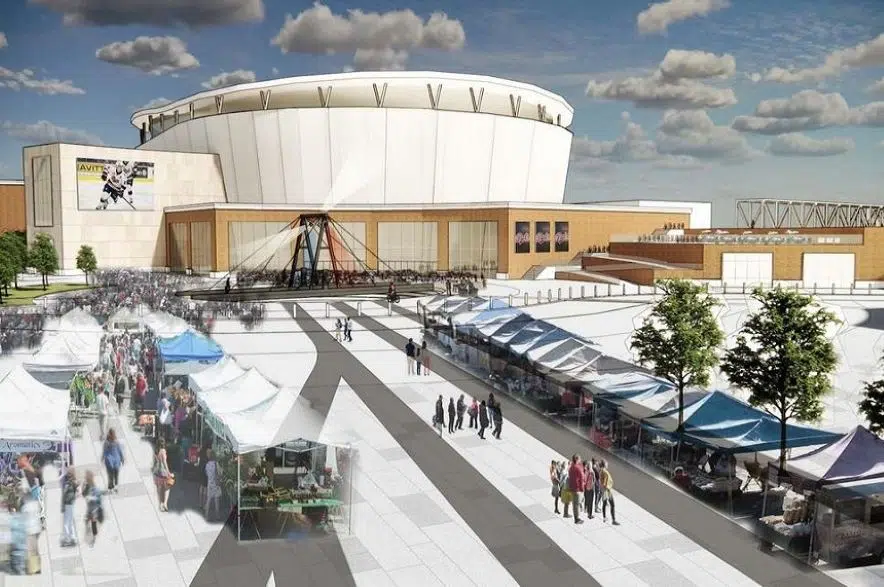After eight months of work, Regina’s catalyst committee is set to present its final report to members of Regina’s executive committee on Wednesday.
The catalyst committee has been working to collect the necessary data for city council members — who make up the executive committee — so they can discuss how they’ll approach several mega-projects going forward.
The report and findings have been public since this past weekend, but members of the media were provided access to an early presentation on Tuesday.

Coun. Bob Hawkins (left) and REAL District CEO Tim Reid discuss the catalyst committee report on Feb. 28, 2023. (Shane Clausing/980 CJME)
During the presentation, Coun. Bob Hawkins and REAL president and CEO Tim Reid explained how they helped come up with the plan. It included how much a new arena, library and aquatics centre could cost and also what a non-vehicular trail connecting downtown with all the venues could look like.
None of the projects the committee has come up with are final. Most don’t have funding secured except for the trail. The aquatics centre is in the process of submitting an application to get federal funding approved.
“Sometimes, government money becomes available quickly and they want an application. Unless you’re shovel ready and can pull it down off the shelf, you’ll lose the opportunity,” Hawkins said. “I think that for all of these catalyst projects through time, one of the reasons we needed to do this planning exercise was so that we could be shovel ready.”
Last month, council received $3 million towards a non-vehicular trail system which will support connectivity to downtown Regina. Hawkins says because that project was already in the works as a path to connect Mosaic Stadium to downtown, the city was able to secure that funding.
“It’s a really good example of if you have a plan and the money falls from the sky, we as the City of Regina should be in a place to grab it. We just have to be planned to access it,” said Reid.
Another reason why the committee wants council to have these projects shovel ready is so they can try to avoid rising project costs from inflation.
Hawkins feels it’s crucial to have a plan to get the projects built in a suitable amount of time assuming the funding is there.
“Inflation is worrying. Anyone who does home repairs knows this is a problem,” Hawkins said. “The first lesson about inflation is if you can find a way to do it, do it now, because in 10 years it’s going to be more expensive.”
While it’s not known if or when the major projects will be built, Hawkins hopes the report will generate interest from the private sector.
“We hope that the catalyst report will spur private investment and suggest ideas to entrepreneurs about where they might want to make contributions and get involved in this,” Hawkins said. “Part of our function is to say, ‘Let’s get on with it. The moment is now.’ We need private interest and private investment and I hope it’s something it spurs.”
Both Reid and Hawkins know not everyone will be supportive of the projects and some feel the city’s efforts should be put towards ending homelessness and solving other issues the city faces.
But Hawkins says as a city that will grow to have a population of 300,000 by 2030, they need to do both.
“The city has to do more than one thing at a time,” he said. “I think catalyst projects are important. They’re important for the economic lift for the city, they’re important for the areas in which they’re going to be built and they’re important for the employment opportunities they create.
“I don’t think it’s a question of saying, ‘We’re only going to do this priority or fix potholes and not do any catalyst projects until we get every pothole filled.’ It’s just not a realistic way to run a city. We have to find a balance.
“We have to look after things like underground infrastructure, (we have to) make sure the city is inclusive and healthy, and we’ve got to have catalyst projects. We’ve got a whole bunch of stuff on our agenda and we’re up to it. If we’re not up to it, our city is going to become weaker and weaker, so we want to build a city that has the amenities and compassion and empathy for all the citizens to use in the city.”
If built, the arena could be located downtown, the aquatics centre could be on the current Lawson Aquatic Centre site, and the library also could be downtown.
During public feedback, some suggested the arena be built on REAL District grounds rather than downtown.
However, Hawkins said the committee suggested an arena be built downtown because it’s the best place for it to succeed.
“If the arena is going to have a catalyzing effect, its best chance of doing that is it being downtown,” he said. “That’s going to attract commercial activity around the arena and if it’s located properly, (it’ll) relate to other projects.
“In a number of Canadian cities, arenas have been moved or built downtown. So the reason for putting the arena downtown is because of the importance of activating our downtown. We haven’t really done a good job of it. We’re struggling downtown and lost ground the last couple of years.”
Chamber of Commerce weighs in
The Regina and District Chamber of Commerce has come out in favour of initiatives like the proposed aquatic centre, downtown library and multi-purpose event centre.
“I think the recommendation is to make sure that they’re building the pieces (of the infrastructure) as the funding comes in,” Chamber CEO Tony Playter told the Greg Morgan Morning Show. “So I think there’s a strategic approach to what will be built first.”
Playter believes funding for these projects should come from all levels of government, as well as support from taxpayers and the private sector.
“I think it needs to be a combination to make it work,” he said.
Playter said he views the aquatic centre and the library as the two biggest priorities.
“Anytime you can have a world-class recreational facility like that, it benefits not only our residents but it also will attract competition and people to our city,” he said.
He would also like to see the arena built downtown, although the catalyst committee has yet to settle on a location.
“If it fits the model that they’re talking about strategically, then we need to do it,” Playter said. “A vibrant and active downtown is good for our province and good for our city and it will attract growth.”
— With files from 980 CJME’s Daniel Reech











